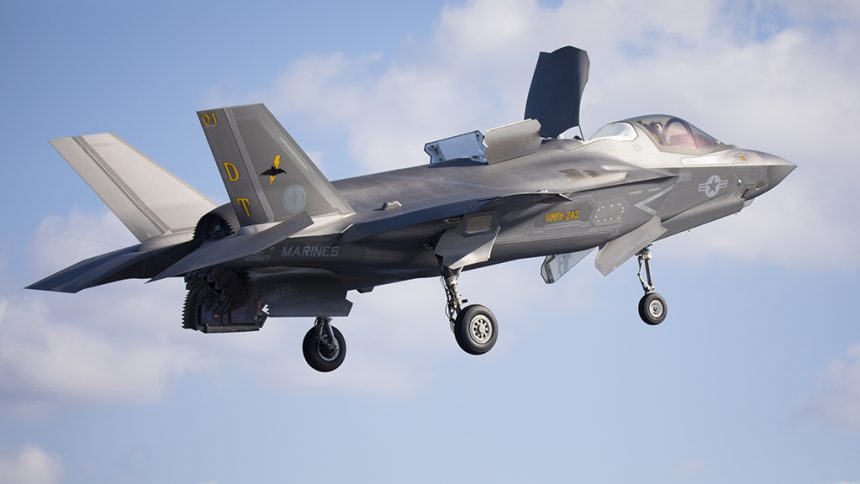The U.S. Marine Corps F-35s are the first fixed-wing aircraft to operate from a Japanese ship since WW2, following the decision to convert the JS Izumo from helicopter carrier to light aircraft carrier and the plan to buy 42 F-35Bs.
The Japanese MInistry of Defense announced today the first landing of U.S. Marine Corps F-35B Lightning II jets on the JS Izumo, posting on Twitter photos and videos of the historic event. The JS Izumo completed the first part of the modifications required for the conversion from helicopter carrier to light aircraft carrier, becoming the first ship of this type in the Japan Maritime Self-Defense Force since WW2. Also, the F-35s became the first fixed-wing aircraft to operate from a Japanese ship since WW2.
The JS Izumo is the lead ship of the Izumo class and, together with its sister ship JS Kaga, is the largest ship of the JMSDF. First launched in 2013, the Izumo already incorporated some design features to allow operations with fixed-wing wing aircraft, but the decision to finally convert it in an aircraft carrier only came in 2018. The first part of the modification works begun last year, with the ship receiving a new heat-resistant flight deck, new power supply equipment, lightning and deck markings.
Oct 3rd, #JMSDF conducted verification of takeoff and landing of #F-35B on #JS Izumo with the assistance of the U.S. MOD will continue to strengthen #Japan-U.S. Alliance.#interoperability pic.twitter.com/viZG8UQA2D
— Japan Ministry of Defense/Self-Defense Forces (@ModJapan_en) October 5, 2021
At the request of the Japan Maritime Self-Defense Force, Marine Fighter Attack Squadron 242, @1stMAW_Marines, conducted the first ever landing of two F-35B Lightning II aircraft aboard the Japanese Ship Izumo on October 3, 2021. @jmsdf_pao_eng pic.twitter.com/CcWlzkHwdg
— U.S. Marines (@USMC) October 5, 2021
The JMSDF then requested the collaboration of the United States for the testing, with the USMC deploying two F-35Bs of the Marine Fighter Attack Squadron (VMFA) 242 “Bats” that landed on the Izumo for the first time on October 3, 2021. The two jets’ role is to verify that the F-35B can safely perform flight operations from the JS Izumo’s flight deck, before work resumes for the second round of modifications that will also involve the reshaping of the flight deck’s tapered ending to a squared surface.
For these trials, the JS Izumo was deployed to Iwakuni for a port visit before the beginning of the activities. MCAS Iwakuni is also home of VMFA-242, permanently stationed there together with VMFA-121 “Green Knights”. The unit declared the Initial Operational Capability last month, just 10 months after beginning the transition from the F/A-18 Hornet to the F-35B. During the trials, their F-35 also received the JS Izumo insignia on the tail, with a pilot showing a similar patch after landing.
3 OCT, the #JMSDF conducted verification of takeoff and landing of the USMC F-35B to JS #IZUMO.
The JMSDF continues to steadily carry out the necessary modifications to the IZUMO class to acquire the capability to operate the F-35Bs. pic.twitter.com/0gtPNzrxQC
— Japan Maritime Self-Defense Force (@jmsdf_pao_eng) October 5, 2021
“This trial has proved that the JS Izumo has the capability to support takeoffs and landings of STOVL aircraft at sea, which will allow us to provide an additional option for air defense in the Pacific Ocean in the near future”, said JMSDF Rear Admiral Shukaku Komuta, commander of Escort Flotilla One. “We still have work to do until the day the JSDF can regularly employ STOVL aircraft at sea, but I am confident that the strong partnership and mutual trust between our two counties will result in its realization.”
Following the decision to convert Izumo and Kaga from helicopter carriers to aircraft carriers, Japan decided to acquire an additional 100 F-35s, of which 42 are F-35Bs. The first 18 STOVL (Short Take-Off and Vertical Landing) aircraft are expected to be delivered in 2023, forming the first of two Japanese F-35B squadrons. It is estimated that about 12/14 F-35Bs can be embarked on the Izumo when operational.
Kon’nichiwa, Izumo 🇯🇵 🤝 🇺🇸
JS #Izumo arrived at @USMC Air Station Iwakuni, Japan, Sept. 30, 2021 for a scheduled port visit.#BlueGreenTeam #NavyPartnerships pic.twitter.com/TQf3m5Sfrr
— U.S. Navy (@USNavy) September 30, 2021
“We have the utmost confidence in the Joint Strike Fighter and are eager for our Japanese allies to have the same capabilities in their hands, which ultimately contributes to our shared goal of maintaining a free and open Indo-Pacific,” said Major General Brian W. Cavanaugh, 1st Marine Aircraft Wing Commanding General.









